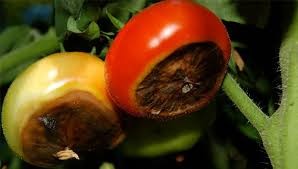Home » Say goodbye to blossom end rot: The right mix for the right crop

For tomato growers, few problems are as frustrating as blossom end rot (BER). Those dark, sunken patches on the bottom of otherwise perfect tomatoes can ruin a harvest and leave even experienced farmers scratching their heads. While many factors contribute to BER, your growing medium plays a crucial role—and that’s where coco coir substrates like Pelemix are changing the game for commercial and home growers alike.
A physiological disorder, not a disease
It’s important to understand that blossom end rot is not caused by a pathogen—it’s not a disease, virus, or fungal infection despite its round shape that might resemble pathogen damage. BER cannot spread between plants. BER is purely a physiological disorder resulting from calcium deficiency in the developing fruit. This distinction is crucial because the solutions involve optimizing growing conditions rather than applying fungicides or other treatments that target pathogens.
More than just a calcium (Ca²⁺) deficiency

Blossom end rot is often misunderstood as simply a calcium deficiency in the soil/substrate. While calcium is indeed central to the problem, the reality is more complex. BER occurs when fruits cannot absorb enough calcium during development. This can happen even when there’s plenty of calcium in your growing medium.
The key issue is calcium mobility: Due to the immobility of calcium through the phloem, it depends solely on xylem transport that flows one way—from bottom to top only. When transpiration is limited, calcium simply cannot reach developing fruits.
According to research, calcium transport to fruit is highly dependent on environmental conditions and plant physiology rather than just calcium levels in the root zone (Ho et al., 20181). Their study found that water stress was often the primary trigger for BER, even in calcium-rich environments.
The real culprits behind BER include:
Why traditional growing media falls short
Many conventional growing media have inherent limitations that make them prone to conditions that cause BER: 
These limitations create the perfect storm for blossom end rot to develop, especially during the critical fruiting stage when tomato plants need precise nutrient balance and moisture levels.
The Coco Coir revolution for tomato growers: The right mix for the right crop
Coco coir substrates like Pelemix offer a superior growing environment that addresses the causes of blossom end rot. When we say “the right mix for the right crop,” we’re emphasizing how Pelemix coco coir is specifically formulated to meet the exacting needs of calcium-demanding crops like tomatoes.
Exceptional water management
Pelemix coco coir holds water while maintaining excellent aeration—the perfect balance for calcium uptake. Its unique fibrous structure creates:
This balanced hydration environment ensures calcium remains mobile and available to developing fruits, significantly reducing BER incidents. A comprehensive study in HortScience demonstrated that coco coir-based substrates maintained more stable moisture content throughout the root zone compared to peat-based media, resulting in fewer instances of calcium-related disorders in tomato production (Barrett et al., 20162).
Root development and health
Healthy roots are essential for nutrient uptake. Pelemix coco coir creates an ideal environment for robust root development:
Research published in Scientia Horticulturae found that tomato plants grown in coco coir exhibited 27% greater root mass and significantly improved calcium uptake efficiency compared to conventional media (Xiong et al., 20173). With a stronger root system, tomato plants can efficiently transport calcium to developing fruits, even during periods of high stress or rapid growth.
Climate challenges in soilless production: Understanding calcium mobility
Soilless production systems like those using coco coir face unique challenges related to climate conditions. Unlike traditional soil cultivation, container-grown tomatoes in controlled environments experience:
These climate factors are particularly problematic for calcium nutrition because of calcium’s unique mobility constraints. The right mix for the right crop becomes even more critical in these challenging growing environments.
Making the Switch to Coco Coir: Best Practices
When transitioning to Pelemix coco coir for your tomato production—truly embracing the right mix for the right crop—follow these guidelines:

Sustainability bonus
Beyond the agronomic benefits, choosing coco coir means embracing sustainability:
Conclusion: The Pelemix difference
Blossom end rot doesn’t have to be an accepted part of tomato growing. By choosing a superior growing medium like Pelemix coco coir—the right mix for the right crop—you’re addressing the fundamental causes of calcium transport issues that lead to BER.
Whether you’re a commercial producer looking to maximize marketable yield or a home gardener tired of throwing away affected fruits, the switch to quality coco coir substrate represents one of the most effective changes you can make to your growing system.
A long-term comparative study in the Journal of Agricultural and Food Chemistry concluded that “coir-based growing media consistently outperformed conventional substrates in maintaining calcium homeostasis in fruiting vegetables, with particular benefits observed during periods of environmental stress” (Dorais & Perez, 2020). This scientific backing confirms what growers using Pelemix already know: healthy roots, consistent moisture, and available calcium—these are the foundations of BER prevention, and they’re exactly what Pelemix coco coir delivers to your tomato plants every day.
References